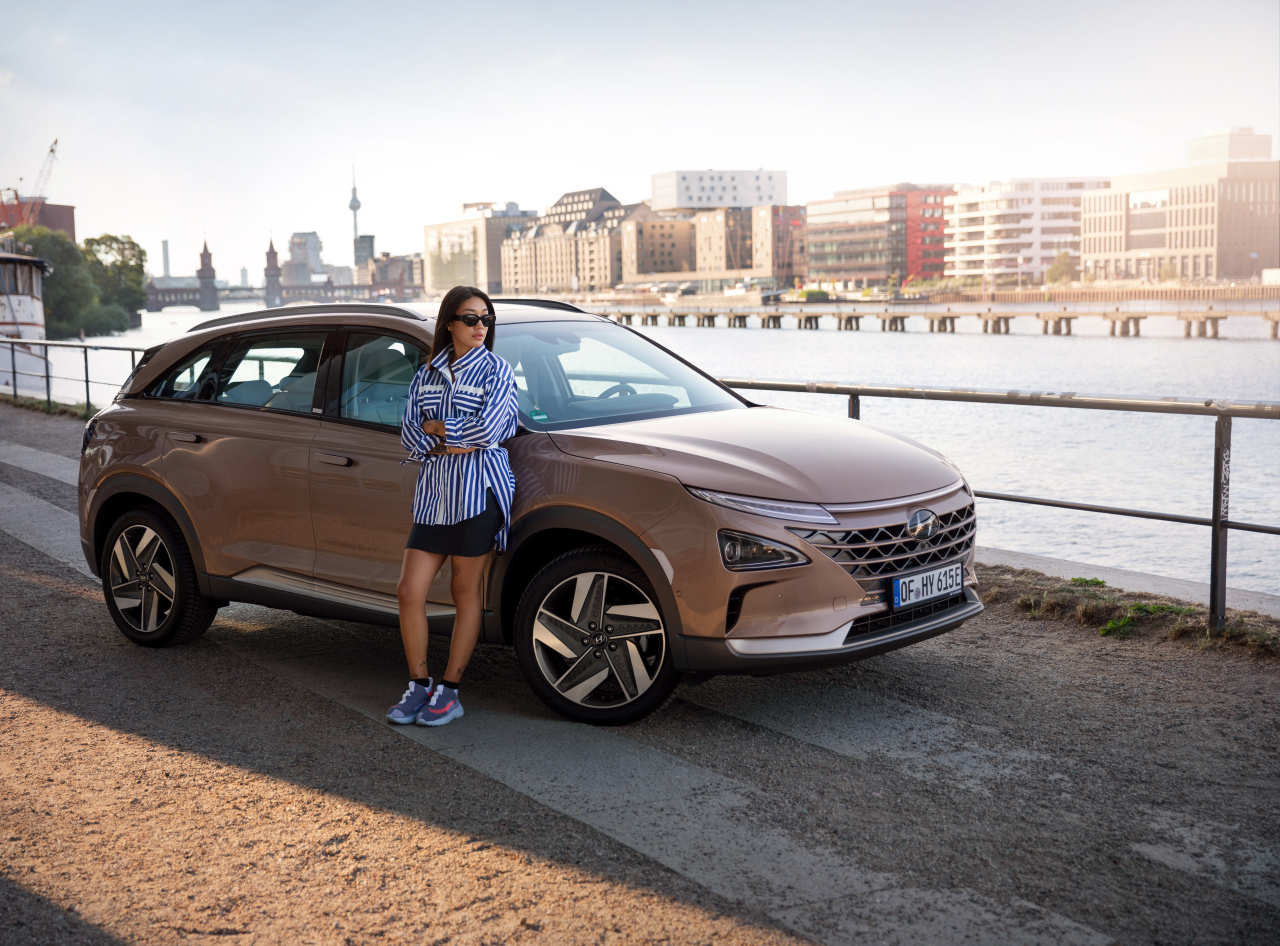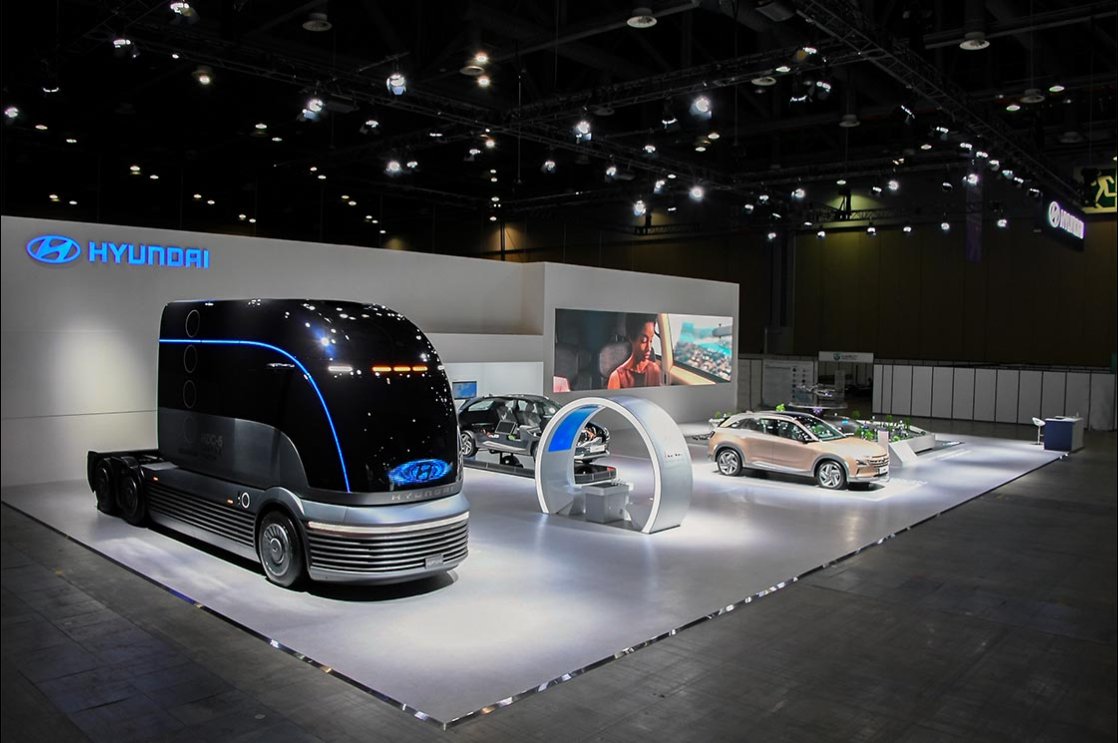 |
Hyundai Motor’s “Hydrogen to you” campaign promotes hydrogen energy to Europe. (Hyundai Motor) |
The automotive industry is competing to introduce the most environment-friendly vehicles as global society strives to reach zero emissions.
Battery-powered or hydrogen fuel cell cars have emerged as alternatives to gas or diesel-powered automobiles.
While battery electric vehicles appear to have a slight lead on the roads for now, Hyundai Motor Group is committed to fostering a “hydrogen society,” in the belief that hydrogen fuel cells will be equally competitive in achieving a green future and possibly more efficient in fuel use and overall emissions.
“Producing electricity with hydrogen is an environmentally-friendly solution for the future, and it will grow into a core industry,” Chung Euisun, chairman of Hyundai Motor Group, recently said.
Hyundai, which came up with the world’s first mass-produced fuel cell electric vehicles (FCEV), retained its top rank in the field in 2020. According to SNE Research, the company made 73.8 percent of the total 6,600 FCEVs sold around the world from January to September -- beating Japanese rivals Toyota and Honda.
Hyundai is aggressively expanding its hydrogen business to develop not only passenger cars, but also commercial vehicles and fuel cell systems that are globally competitive.
Announcing its own long-term plan dubbed “Fuel Cell Vision 2030” in December 2018, the automaker said it aims to produce 700,000 fuel-cell systems annually by 2030, which includes 500,000 units of FCEVs.
By that time, the automaker anticipated the global demand for FCEVs would be around 2 million units a year.
The company has said it will, with its suppliers, invest about 7.6 trillion won ($6.8 billion) in research and development, and facility expansion as well.
Hyundai’s relationship with fuel cells began in 1998, when it first established a fuel cell development unit. Two years later, the unit built its first product, a FCEV version of its iconic sports utility model Santa Fe.
The company gradually shaped its business around fuel cell technology in the coming years and it introduced an in-house fuel cell system in 2005. Then the automaker surprised the world by debuting the world’s very first mass-produced FCEV, the Tucson ix35, in 2013, winning several local and international awards, including the Future Auto Awards at the Brussels Motor Show.
In 2018 followed the Nexo SUV, the company’s second FCEV passenger car. First debuted at that year’s CES, the model was an improvement in all possible ways from the predecessor and was on par with conventional vehicles.
Tested by South Korean authorities, the Nexo recorded the longest battery range in the world for a FCEV, of 609 kilometers on a single charge. It proved to be a successful zero-emission car with autonomous driving capabilities.
Following its road map to cement its top position as a hydrogen-powered vehicle brand, Hyundai became the world’s first carmaker to mass-produce hydrogen electric trucks, the Xcient Fuel Cell, last year.
The first batch of Xcient Fuel Cell was exported to Switzerland, and the company said it plans to expand sales of the heavy-duty truck to other European countries as well as the North American market.
In 2020, Hyundai exported Elec City FCEVs, a hydrogen-powered bus model that can run about 430 kilometers on a single charge, to Saudi Arabia.
 |
Hyundai Motor's HDC-6 Neptune Concept (Hyundai Motor Group) |
In the next three to four years, Hyundai plans to launch new FCEVs of both passenger cars and heavy-duty trucks, the company said.
In July last year, the automaker unveiled the concept for a new hydrogen-powered truck, the HDC-6 Neptune.
As Hyundai Motor Group aims to transform into a mobility solution group, the company is also advancing with its fuel cell system, which would be applied to other forms of mobility, such as vessels, drones and trains.
In September, the company exported its fuel cell system based on the one used in the Nexo to a Swiss hydrogen solution firm GRZ Technologies for non-automotive uses.
According to Hyundai, the Swiss company intends to use the system to create a stationary power supply system for generating electricity in peak times.
The automotive company also launched an official brand for its hydrogen fuel cell system, HTWO. The brand name HTWO stands for H2, the hydrogen molecule.
Not wanting to miss out on opportunities overseas, Hyundai is also building ties with the Chinese government and firms, as Beijing has announced a fuel cell road map of its own to supply 1 million hydrogen electric cars by 2030.
In November, Hyundai Motor signed deals with a number of Chinese companies to provide a total of 4,000 fuel cell trucks by 2025.
In the latest move, Hyundai signed an agreement with a Chinese provincial government to establish its first offshore fuel cell system plant in Guangzhou, China, on Jan. 15.
The plant, which will be constructed in the second half of 2022, is planned to initially produce 6,500 fuel cell systems a year, and the capacity will be increased gradually with the market demand.
Hyundai’s hydrogen strategy is expected to gain momentum, as it goes hand in hand with the incumbent Moon Jae-in Administration’s Green New Deal policy, aimed at transitioning the country to a net-zero emissions economy by fostering “green” technologies in fields including the mobility sector.
By Jo He-rim (
herim@heraldcorp.com)



![[KH Explains] Why Yoon golfing is so controversial](http://res.heraldm.com/phpwas/restmb_idxmake.php?idx=644&simg=/content/image/2024/11/13/20241113050608_0.jpg)





![[KH Explains] For Korean automakers, Chinese EVs may loom larger than Trump’s tariffs](http://res.heraldm.com/phpwas/restmb_idxmake.php?idx=644&simg=/content/image/2024/11/14/20241114050537_0.jpg)